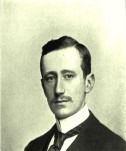Things To Make by Archibald Williams is part of the HackerNoon Books Series. You can jump to any chapter in this book here. A HOME-MADE PANTOGRAPH
XXXVI. A HOME-MADE PANTOGRAPH.
The pantograph is a simple apparatus for copying drawings, maps, designs, etc., on a reduced or enlarged scale, or to the same size as the original.
[Illustration: FIG. 186.—Details of simple pantograph.]
A sketch of a pantograph is given in Fig. 186. Four rods are jointed together to form a parallelogram, the sides of which can be lengthened or shortened to suit the scale of reproduction. One is attached by a fixed pivot at a to the board on which the drawing is done. At b and e are removable pivots, used for adjusting the rods; at c is a pivot which projects an inch or so below the rods. The pointer is inserted at d for enlargement, or at f for reduction, the pencil being in the unoccupied hole at d or f.
If a same-sized copy is desired, the fixed pivot is transferred to d, and the pencil and pointer placed at a and f respectively.
Construction of an Enlarging and Reducing Pantograph.—Cut out of 1/8-inch oak, walnut, or beech four rods 5/8 inch wide and 19 inches long. Smooth them well all over, and make marks near the ends of each, exactly 18 inches apart. The graduation of the rods for the adjustment pivot holes is carried out in accordance with the measurements given in Fig. 187. It is advisable to mark out and bore each rod separately if you do not possess a machine which will drill holes quite perpendicularly; if you do, all four rods can be drilled at one operation.
In Fig. 187 the lower row of numerals indicates the number of times (in diameters) the original is enlarged when all four holes similarly figured are used; the upper row, the size of the copy as compared with the original in case of reduction.
If proportions other than those given are required, a very little calculation will locate the necessary holes.
Pivots.—All the pivots must fit their holes accurately, as any looseness at the joints detracts from the truth of reproduction. For pivots band b and e may use brass screws and small pieces of hard wood as nuts to hold them in position. The nuts should screw on rather stiffly, and not be forced hard against the rods, as free motion with little friction at all joints is essential for good work.
[Illustration: FIG. 187.—Diagram showing how to mark off pantograph rods. The dotted lines above rod give distances of holes from ends.]
The fixed pivot at a may be merely the shank of a wire nail of the proper size driven into the board, a cork collar being slipped over it to keep the rod the proper distance from the board. For c use a screw to the head of which has been soldered half an inch of a round-headed brass nail, which will move easily over the paper. At d is needed a hollow pivot, fashioned out of a quarter of an inch of pencil-point protector or some other thin tube, burred over slightly at the ends so as not to fall out. The end of B at f has a slotted hole to grip the pencil or pointer, as the case may be.
A Same-size Pantograph.—For making a same-size copy, tracing may be preferred to the use of a pantograph; but if a pantograph is adopted, a special apparatus may be constructed for the purpose. The arrangement is exactly the same as that already described, excepting that the only holes needed are those at a, c, d, f, at the middle points of the four rods, the parallelogram formed by the rods being equal-sided. The fixed pivot is situated at d, and pencil and pointer holes are made at a and f.
Using the Pantograph.—When adjusting the instrument for reduction or enlargement, make sure that the adjustment pivots are in the holes corresponding with the scale. The fixed pivot, pointer, and pencil must be rigid, and, with pivot c, be of such a length that the pantograph as a whole moves parallel to the paper. A little sliding weight to place on the rod near the pencil will be found useful for keeping the pencil point in constant contact with the paper.
If the apparatus works stiffly, ease the holes a trifle and lead-pencil the wood at all points where two surfaces rub. It is absolutely impossible to make a good reproduction with a stiff, jerky pantograph.
To decide the positions of original and the paper for the copy, get the pointer centred on the original and adjust the paper till its centre is under the pencil.
About HackerNoon Book Series: We bring you the most important technical, scientific, and insightful public domain books.
This book is part of the public domain. Archibald Williams (2005). Things To Make. Urbana, Illinois: Project Gutenberg. Retrieved https://www.gutenberg.org/cache/epub/14664/pg14664-images.html
This eBook is for the use of anyone anywhere at no cost and with almost no restrictions whatsoever. You may copy it, give it away or re-use it under the terms of the Project Gutenberg License included with this eBook or online at www.gutenberg.org, located at https://www.gutenberg.org/policy/license.html.

